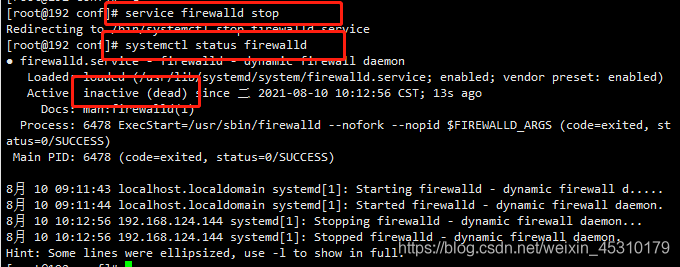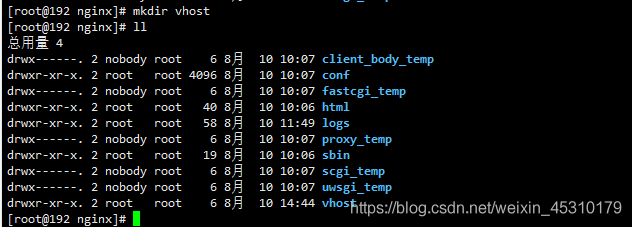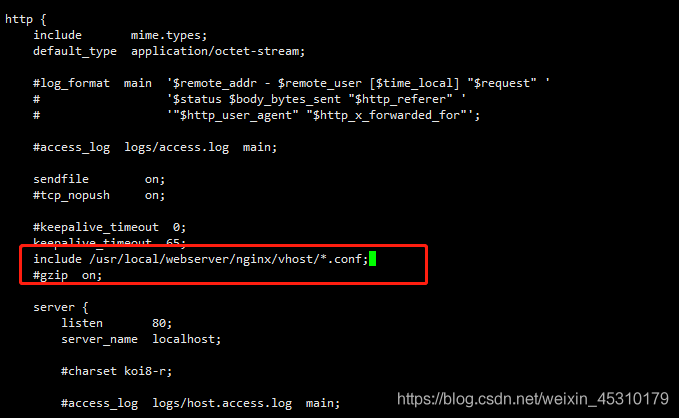centos7 编译安装lnmp环境(PHP篇二)点击查看
https://blog.csdn.net/weixin_45310179/article/details/119572299?spm=1001.2014.3001.5501
centos7 编译安装lnmp环境(MySQL篇三)点击查看
https://blog.csdn.net/weixin_45310179/article/details/119596424?spm=1001.2014.3001.5502
一:Nginx 安装配置
1、安装编译工具及库文件
yum -y install make zlib zlib-devel gcc-c++ libtool openssl openssl-devel
2、首先要安装 PCRE
PCRE 作用是让 Nginx 支持 Rewrite 功能。
下载 PCRE 安装包,下载地址: http://downloads.sourceforge.net/project/pcre/pcre/8.35/pcre-8.35.tar.gz
进入到下载目录(自己选择下载文件保存的目录)
wget http://downloads.sourceforge.net/project/pcre/pcre/8.35/pcre-8.35.tar.gz

解决上述wget未找到问题(如果已经安装,则不会出现该问题)

重新下载,下载完成进入到下载目录,如果未退出,此时应该还在刚才的下载目录位置(/usr/local/src)

解压安装包
tar zxvf pcre-8.35.tar.gz

进入安装包目录
cd pcre-8.35
编译安装
./configure
make && make install
查看pcre版本
pcre-config --version

3、下载nginx
下载 Nginx,下载地址:https://nginx.org/en/download.html
cd /usr/local/src/
wget http://nginx.org/download/nginx-1.6.2.tar.gz


解压安装包:
tar zxvf nginx-1.6.2.tar.gz
进入安装包目录
cd nginx-1.6.2
编译安装
./configure --prefix=/usr/local/webserver/nginx --with-http_stub_status_module --with-http_ssl_module --with-pcre=/usr/local/src/pcre-8.35

make

make install

启动 Nginx,Nginx 启动命令如下:(任意位置都可以启动)
/usr/local/webserver/nginx/sbin/nginx

访问站点(如果出现下述问题,检测防火墙状态)

systemctl status firewalld

关闭防火墙,并查看防火墙状态
service firewalld stop

防火墙已关闭,再次访问站点,成功

Nginx 其他命令,以下包含了 Nginx 常用的几个命令:
/usr/local/webserver/nginx/sbin/nginx -s reload # 重新载入配置文件
/usr/local/webserver/nginx/sbin/nginx -s reopen # 重启 Nginx
/usr/local/webserver/nginx/sbin/nginx -s stop # 停止 Nginx
查看nginx版本

解决方式:
打开环境变量所在的文件:
vi /etc/profile

在profile文件末尾,加上一行(你的nginx安装位置)
PATH=$PATH:/usr/local/webserver/nginx/sbin

重新加载环境,解决
source /etc/profile

如果想用service nginx start(stop,restart)的方式开启、停止和重启nginx,则会出现以下问题

解决方法:
是因为nginx没有有添加到系统服务,手动手动添加一个即可。
在 /etc/init.d/下创建名为nginx的启动脚本即可,内容如下:
#!/bin/sh
#
# nginx - this script starts and stops the nginx daemon
#
# chkconfig: - 85 15
# description: NGINX is an HTTP(S) server, HTTP(S) reverse
# proxy and IMAP/POP3 proxy server
# processname: nginx
# config: /etc/nginx/nginx.conf
# config: /etc/sysconfig/nginx
# pidfile: /usr/local/webserver/nginx/logs/nginx.pid
# Source function library.
. /etc/rc.d/init.d/functions
# Source networking configuration.
. /etc/sysconfig/network
# Check that networking is up.
[ "$NETWORKING" = "no" ] && exit 0
nginx="/usr/local/webserver/nginx/sbin/nginx"
prog=$(basename $nginx)
NGINX_CONF_FILE="/usr/local/webserver/nginx/conf/nginx.conf"
[ -f /etc/sysconfig/nginx ] && . /etc/sysconfig/nginx
lockfile=/var/lock/subsys/nginx
make_dirs() {
# make required directories
user=`$nginx -V 2>&1 | grep "configure arguments:" | sed 's/[^*]*--user=([^ ]*).*/1/g' -`
if [ -z "`grep $user /etc/passwd`" ]; then
useradd -M -s /bin/nologin $user
fi
options=`$nginx -V 2>&1 | grep 'configure arguments:'`
for opt in $options; do
if [ `echo $opt | grep '.*-temp-path'` ]; then
value=`echo $opt | cut -d "=" -f 2`
if [ ! -d "$value" ]; then
# echo "creating" $value
mkdir -p $value && chown -R $user $value
fi
fi
done
}
start() {
[ -x $nginx ] || exit 5
[ -f $NGINX_CONF_FILE ] || exit 6
make_dirs
echo -n $"Starting $prog: "
daemon $nginx -c $NGINX_CONF_FILE
retval=$?
echo
[ $retval -eq 0 ] && touch $lockfile
return $retval
}
stop() {
echo -n $"Stopping $prog: "
killproc $prog -QUIT
retval=$?
echo
[ $retval -eq 0 ] && rm -f $lockfile
return $retval
}
restart() {
configtest || return $?
stop
sleep 1
start
}
reload() {
configtest || return $?
echo -n $"Reloading $prog: "
killproc $nginx -HUP
RETVAL=$?
echo
}
force_reload() {
restart
}
configtest() {
$nginx -t -c $NGINX_CONF_FILE
}
rh_status() {
status $prog
}
rh_status_q() {
rh_status >/dev/null 2>&1
}
case "$1" in
start)
rh_status_q && exit 0
$1
;;
stop)
rh_status_q || exit 0
$1
;;
restart|configtest)
$1
;;
reload)
rh_status_q || exit 7
$1
;;
force-reload)
force_reload
;;
status)
rh_status
;;
condrestart|try-restart)
rh_status_q || exit 0
;;
*)
echo $"Usage: $0 {start|stop|status|restart|condrestart|try-restart|reload|force-reload|configtest}"
exit 2
esac
保存。
自己修改自己的nginx路径
nginx="/usr/local/webserver/nginx/sbin/nginx"
NGINX_CONF_FILE="/usr/local/webserver/nginx/conf/nginx.conf"

设置执行权限:chmod +x /etc/init.d/nginx
注册成服务:chkconfig --add nginx
设置开机启动:chkconfig nginx on
注意,保存一定要保存成UNIX格式(notepad++:编辑–文档格式转换–转为UNIX格式),否则会如下报错的

解决办法,不要去手动创建文件,使用vi nginx创建文件,并把内容复制进去

运行一下systemctl daemon-reload

之后,就可以使用以下命令了
service nginx start
service nginx stop
service nginx restart
Nginx 配置:(原始配置文件nginx.conf不变,新建一个文件夹用于存放后续的所有配置文件,位置任意,后续需要在nginx.conf中配置,我是放到nginx目录下与conf同级)
 vi /usr/local/webserver/nginx/conf/nginx.conf
vi /usr/local/webserver/nginx/conf/nginx.conf

在http模块新增下面的内容,地址就是你的新建文件夹的路径

创建一个新的配置文件,配置内容如下,将域名和项目路径以及错误日志文件修改为自己的路径

server {
listen 80;
server_name www.lnmp.com;
charset utf-8;
index index.html index.htm index.php;
root /www/blog/public;
proxy_connect_timeout 600s;
proxy_send_timeout 600s;
proxy_read_timeout 600s;
send_timeout 300s;
fastcgi_connect_timeout 600;
fastcgi_send_timeout 600;
fastcgi_read_timeout 600;
uwsgi_read_timeout 600;
#limit_conn perip 2;
#limit_conn perserver 4;
#proxy_read_timeout 6;
#keepalive_timeout 1s;
#location /api/banners/ {
# limit_conn perserver 4;
#}
location / {
try_files $uri $uri/ /index.php$is_args$args;
}
location = /favicon.ico { access_log off; log_not_found off; }
location = /robots.txt { access_log off; log_not_found off; }
error_log /usr/local/webserver/nginx/logs/tbk_nginx_error.log error;
error_page 404 /index.php;
location ~ /. {
deny all;
}
location ~ .*.(woff|js|css|png|jpg|gif|swf|ico|pdf|mov|fla|zip|rar)$ {
try_files $uri =404;
}
location ~ .*.(woff|jpg|jpeg|png|gif|ico|css|js)$ {
expires 1h;
add_header Cache-Control public;
add_header Pragma public;
add_header Vary Accept-Encoding;
}
location ~ .php(.*)$ {
fastcgi_pass 127.0.0.1:9000;
fastcgi_index index.php;
fastcgi_split_path_info ^((?U).+.php)(/?.+)$;
fastcgi_param SCRIPT_FILENAME $document_root$fastcgi_script_name;
fastcgi_param PATH_INFO $fastcgi_path_info;
fastcgi_param PATH_TRANSLATED $document_root$fastcgi_path_info;
include fastcgi_params;
}
location ~ /.(?!well-known).* {
deny all;
}
# security headers
add_header X-Frame-Options "SAMEORIGIN" ;
add_header X-XSS-Protection "1; mode=block" ;
add_header X-Content-Type-Options "nosniff" ;
add_header Referrer-Policy "no-referrer-when-downgrade" ;
add_header Content-Security-Policy "default-src * data: 'unsafe-eval' 'unsafe-inline'" ;
add_header Strict-Transport-Security "max-age=31536000; includeSubDomains; preload" ;
# gzip
gzip on;
gzip_vary on;
gzip_proxied any;
gzip_comp_level 6;
gzip_types text/plain text/css text/xml application/json application/javascript application/xml+rss application/atom+xml image/svg+xml;
}
重启nginx,并使用域名访问站点(此时尚未安装PHP,可以先访问html文件,检验配置是否正确)

新建一个html文件

测试访问成功

最后
以上就是俊逸裙子最近收集整理的关于centos7 编译安装lnmp环境(nginx篇一)的全部内容,更多相关centos7内容请搜索靠谱客的其他文章。








发表评论 取消回复